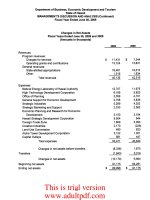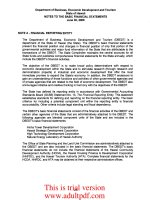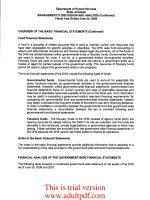FINANCIAL AUDIT OF THE DEPARTMENT OF HUMAN SERVICES STATE OF HAWAII Fiscal Year Ended June 30, 2009_part4 ppt
Bạn đang xem bản rút gọn của tài liệu. Xem và tải ngay bản đầy đủ của tài liệu tại đây (427.08 KB, 11 trang )
Department
of
Human Services
State
of
Hawaii
NOTES
TO
THE BASIC FINANCIAL STATEMENTS
June
30, 2009
NOTE A - FINANCIAL REPORTING ENTITY (Continued)
Commission on Fatherhood: The Commission promotes healthy relationships between
parents and children, emphasizing the important role fathers play
in
the lives of their
children. The Commission promotes, fosters, encourages,
and
financially supports
programs designed
to
educate and train men who are
both
current
and
future fathers
in
effective parenting skills, behaviors and attitudes, strategies for overcoming personal
challenges, and opportunities
to
be
productive responsible contributors
to
their family. The
Commission's operations are reported
in
the special revenue fund.
The
DHS
has considered
all
potential component units for which it
is
financially accountable
and other organizations for which the nature and significance of their relationship with
the
DHS
are such that exclusion would cause the DHS's financial statements
to
be
misleading or
incomplete. The Governmental Accounting Standards
Soard
(GASS)
has
set forth criteria
to
be
considered
in
determining financial accountability.
NOTE B - SIGNIFICANT ACCOUNTING POLICIES
The basic financial statements of the
DHS
have been prepared
in
conformity with accounting
principles generally accepted
in
the United States of America (GAAP),
as
applicable to
governmental units. The GASS
is
the accepted standard-setting body for establishing
governmental accounting and financial reporting principles.
(1)
Basis
of
Presentation - The government-wide financial statements, which are the
statement of net assets and the statement of activities report information of
all
of the
non-fiduciary activities of the
DHS.
The effect of interfund activity
has
been removed
from these government-wide financial statements.
The statement of activities demonstrates the degree
to
which the direct expenses of a
given function are offset
by
program revenues. Direct expenses are those that are
clearly identifiable with a specific function. Program revenues include charges
to
customers who purchase, use, or directly benefit from goods or services provided
by
a
given function. Program revenues also include grants and contributions that are
restricted to meeting the operational or capital requirements of a particular function.
State allotments and other items properly excluded from program revenues are
reported instead
as
general revenues. Resources that are dedicated internally are
reported
as
general revenues rather than program revenues.
Net assets are restricted when constraints placed
on
them are either externally
imposed or imposed
by
constitutional provisions
or
enabling legislation. Internally
imposed designations of resources are not presented
as
restricted net assets. When
both restricted and unrestricted resources are available for use, it
is
generally the
DHS's policy to use restricted resources first, then unrestricted resources
as
they are
needed.
34
This is trial version
www.adultpdf.com
Department
of
Human Services
State
of
Hawaii
NOTES TO
THE
BASIC FINANCIAL STATEMENTS
June
30,
2009
NOTE B - SIGNIFICANT ACCOUNTING POLICIES (Continued)
The financial activities are recorded
in
individual funds, each of which
is
deemed to
be
a separate accounting entity. The DHS uses fund accounting to report
on
its financial
position and results of operations. Fund accounting
is
designed to demonstrate the
legal compliance
and
to aid financial management by segregating transactions related
to certain government functions or activities. A fund
is
a separate accounting entity
with a self-balancing set of accounts.
Separate financial statements are provided for governmental funds and fiduciary
funds. However, the fiduciary funds are not included
in
the government-wide financial
statements. Major individual governmental funds are reported
as
separate columns
in
the fund financial statements.
The financial activities of the DHS that are reported
in
the accompanying fund financial
statements have been classified into the following major governmental funds.
In
addition, a description of the DHS' fiduciary fund is as follows.
Governmental Fund Types
The DHS reports the following major governmental funds:
General
Fund
The general fund is the general operating fund of the
DHS.
It
is
used to account for
all
financial activities except those required to
be
accounted for
in
another fund.
The annual operating
bUdget
as authorized by the State Legislature provides the
basic framework within which the resources and obligations of the general fund are
accounted.
Special Revenue Funds
The Special Revenue Funds are used to account for the proceeds of specific
revenue sources that are legally restricted for specific purposes. The Special
Revenue Funds are as follows:
Med-Quest - accounts for the programs related to the health care
programs of the State.
Human Services - accounts for social services programs, which include
public welfare and eligibility and disability determination.
Fiduciary Fund Type
Trust
and
Agency
Funds
Trust
and
agency funds account for various assets held by the DHS
in
a trustee
capacity or
as
an
agent for individuals, private organizations, other governmental
agencies or other funds.
35
This is trial version
www.adultpdf.com
Department
of
Human Services
State
of
Hawaii
NOTES TO THE BASIC FINANCIAL STATEMENTS
June
30, 2009
NOTE B - SIGNIFICANT ACCOUNTING POLICIES (Continued)
(2)
Measurement Focus
and
Basis
of
Accounting
Government-wide Financial Statements - The government-wide financial statements
are reported using the economic resources measurement focus and the accrual basis
of
accounting. Revenues are recorded when earned and expenses are recorded when
a liability
is
incurred, regardless
of
the timing of related cash flows. Grants and similar
items are recognized as revenue as soon as all eligibility requirements have been met.
Governmental Funds Financial Statements - The governmental funds financial
statements are reported using the current financial resources management focus
and
the
modi'Fied-accrual
basis of accounting. Revenues
are
recognized
as
soon as they are
both measurable and available. Revenues are considered to
be
available when they are
collectible within the current period or soon enough thereafter to pay liabilities of the
current period. For this purpose, the DHS considers revenues other than federal grants
and assistance awards to
be
available if they are collected within 60 days
of
the end of
the current fiscal year. Revenues susceptible to accrual include federal grants and funds
appropriated by the State Legislature and allotted
by
the Governor. Expenditures are
generally recorded when the related fund liabilities are incurred.
Federal grants and assistance awards made on the basis
of
entitlement periods are
recorded
as
revenue when available and entitlement occurs which
is
generally within
12
months of the end
of
the current fiscal year. All other federal reimbursement-type grants
are recorded
as
intergovernmental receivables
and
revenues when the related
expenditures or expenses are incurred as of fiscal year-end
and
funds are available.
Expenditures are generally recorded when a liability
is
incurred, as under accrual
accounting. However, debt service expenditures, as well
as
expenditures related to
compensated absences and claims and judgments, are recorded only when payment
is
due.
Encumbrances are recorded obligations
in
the form of purchase orders or contracts. The
State records encumbrances at the time purchase orders or contracts are awarded and
executed. Encumbrances outstanding at fiscal year-end are reported as reservations of
fund balances since they do not constitute expenditures or liabilities.
Fiduciary Funds - Fiduciary funds are used to account for resources held
by
the DHS
as
an
agent for individuals, private organizations, other governmental agencies, and/or
other funds. Fiduciary funds are custodial
in
nature
(Le.,
assets equal liabilities) and do
not involve measurement
of
results of operations. The private purpose trust fund
is
used
to account for donations received by the DHS which are used to benefit clients of the
Ho'opono, Services for the Blind Program under
the
Vocational Rehabilitation and
Services for the Blind division.
36
This is trial version
www.adultpdf.com
Department
of
Human
Services
State
of
Hawaii
NOTES TO THE BASIC FINANCIAL STATEMENTS
June
30, 2009
NOTE B - SIGNIFICANT ACCOUNTING POLICIES (Continued)
(3)
Use
of
Estimates - The preparation
of
the basic financial statements
in
conformity with
accounting principles generally accepted in the United States
of
America requires
management to make estimates and assumptions that affect the reported amounts of
assets and liabilities and disclosures
of
contingent assets and liabilities at the date
of
the
financial statements and the reported amounts
of
revenues and expenditures during the
reporting period. Actual results could differ from those estimates.
(4)
Receivables - Receivables
in
the general and special revenue funds consist primarily of
amounts due from Medicaid providers for a retroactive adjustment to previously made
payments and recipients
of
welfare benefit overpayments. The amounts reported as net
receivables were established based
on
management's estimate
of
amounts collectible.
(5)
Capital Assets - Capital assets include land and land improvements, infrastructure
assets, buildings and improvements, equipment, and all other tangible and intangible
assets that are used
in
operations and that have initial useful lives extending beyond a
single reporting period. Capital assets are recorded at historical cost or estimated
historical cost if purchased or constructed. Donated capital assets are recorded at their
estimated fair market value at the date
of
donation.
Maintenance and repairs are charged to operations when incurred. Betterments
and
major improvements which significantly increase values, change capacities, or extend
useful lives are capitalized. Upon sale or retirement of capital assets, the cost and the
related accumulated depreciation, as applicable,
are
removed from the respective
accounts, and any resulting gain or loss is recognized
in
the statement
of
activities.
Capital assets are depreciated using the straight-line method over the useful lives below.
The State has adopted the following capitalization policy:
Minimum
Capitalization
Estimated
Asset Type
Amount
Useful Life
Land
All
Not applicable
Land improvements
$ 100,000 15 years
Buildings and improvements
$ 100,000
30 years
Furniture and equipment
$
5,000 7 years
Motor vehicles
$
5,000 5 years
37
This is trial version
www.adultpdf.com
Department
of
Human
Services
State
of
Hawaii
NOTES TO THE BASIC FINANCIAL STATEMENTS
June
30,2009
NOTE B - SIGNIFICANT ACCOUNTING POLICIES
(Continued)
(6)
Compensated Absences - The DHS permits employees to accumulate earned but
unused vacation and sick leave benefits. There is no liability for unpaid accumulated sick
leave since sick leave is not convertible to pay upon termination
of
employment. All
vacation pay is accrued when incurred. Employees are credited with vacation at the rate
of
168 hours per calendar year. Accumulation
of
such vacation credits
is
limited to 720
hours at calendar year-end and
is
convertible to pay upon termination
of
employment.
Such accumulated vacation has been accrued and reflected
in
the statement
of
net
assets.
(7)
Due
to
Individuals - Due to individuals represents assets held by the DHS primarily
in
an agent capacity and
is
available to individuals receiving benefits under various
programs primarily through the Electronic Benefits Transfer System.
(8)
Appropriations - Appropriations represent the authorizations granted by the State
Legislature that permit a state agency, within established fiscal and budgetary controls,
to incur obligations and to make expenditures. Appropriations are allotted quarterly. The
allotted appropriations lapse if not expended by
or
encumbered at the end
of
the fiscal
year.
(9)
Operating Grants
and
Contributions - Federal grants and assistance awards are
recorded as intergovernmental receivables and revenues when all eligibility
requirements have been satisfied.
(10)
Intrafund
and
Interfund Transactions - Significant transfers
of
financial resources
between activities included within the same fund are offset within that fund.
(11)
Risk
Management - The DHS
is
exposed to various risks for losses related to torts; theft
of,
damage
to,
or destruction
of
assets; errors or omissions; natural disasters; and injuries
to employees. A liability for a claim for a risk
of
loss
is
established if information indicates
that it
is
probable that a liability has been incurred at the date of the basic financial
statements and the amount
of
the loss
is
reasonably estimable.
(12)
Deferred Compensation Plan - The State offers its employees a deferred
compensation plan created
in
accordance with Internal Revenue Code Section 457. The
plan, available to all state employees, permits employees to defer a portion
of
their
salary until future years. The deferred compensation
is
not available to employees until
termination, retirement, death, or unforeseeable emergency.
All plan assets are held in a trust fund to protect them from claims
of
general creditors.
The State has
no
responsibility for loss due to the investment or failure
of
investment
of
funds and assets
in
the plan, but does have the duty of due care that would be required
of
an ordinary prudent investor. Accordingly, the assets and liabilities
of
the State's
deferred compensation plan are not reported
in
the State's or the DHS's basic financial
statements.
38
This is trial version
www.adultpdf.com
Department
of
Human Services
State
of
Hawaii
NOTES TO THE BASIC FINANCIAL STATEMENTS
June
30,
2009
NOTE C - BUDGETING AND BUDGETARY CONTROL
Revenue estimates are provided to the State Legislature at the time of budget consideration
and are revised and updated periodically during the fiscal year. Amounts reflected
as
budgeted revenues
in
the statement of revenues and expenditures - budget and actual
(budgetary basis) - are derived primarily from acts of the State Legislature and from other
authorizations contained
in
other specific appropriation acts
in
various Session Laws of
Hawaii (SLH). Budgeted expenditures are derived primarily from the Supplemental
Appropriations Act of 2008 (Act 158, SLH 2008), and from other authorizations contained
in
the State Constitution, HRS, and other specific appropriation acts
in
various SLH.
All expenditures of these appropriated funds are made pursuant to the appropriations
in
the
fiscal 2008 - 2009 biennial budget. The general and special revenue funds have legally
appropriated annual budgets.
The final legally adopted budget
in
the accompanying statement of revenues
and
expenditures - budget and actual (budgetary basis) - general and special revenue funds
represents the original appropriations, transfers, and other legally authorized legislative
and
executive changes.
The legal level of budgetary control
is
maintained at the appropriation line item level
by
department, program, and source of funds as established
in
the appropriations act. The
Governor
is
authorized to transfer appropriations between programs within the same
department and source of funds; however, transfers of appropriations between departments
generally require legislative authorization. Records and reports reflecting the detail level of
control are maintained by and are available at the State Department of Accounting
and
General Services. During the fiscal year ended June
30,
2009, there were
no
expenditures
in
excess of appropriations
in
the individual funds.
To the extent not expended or encumbered, general fund appropriations generally lapse
at
the end of the fiscal year for which the appropriations are made. The State Legislature
specifies the lapse dates and any other contingencies which may terminate the
authorizations for other appropriations.
Budgets adopted
by
the State Legislature for the general and special revenue funds are
presented
in
the accompanying statement of revenues and expenditures - budget and actual
(budgetary basis). The DHS's annual budget
is
prepared
on
the modified accrual basis of
accounting with several differences from the preparation of the statement of revenues,
expenditures, and changes
in
fund balances, principally related to
(1)
encumbrance of
purchase orders and contract obligations,
(2)
accrued revenues and expenditures, and
(3)
unbudgeted programs (federal award programs). The first two differences represent
departures from GAAP.
The following schedule reconciles the budgetary amounts to the amounts presented
in
accordance with GAAP for the fiscal year ended June
30,
2009.
39
This is trial version
www.adultpdf.com
Department
of
Human Services
State
of
Hawaii
NOTES TO THE BASIC FINANCIAL STATEMENTS
June
30,
2009
NOTE C - BUDGETING AND BUDGETARY CONTROL (Continued)
Human
General
Med-Quest Services
Excess
of
revenues over (under) expenditures and
other
uses - actual on a budgetary basis
$
37,781,166
$ (15,458,809)
$
14,285,755
Reserved for encumbrances at fiscal year-end
14,409,444
66,741,495 29,918,893
Expenditures for liquidation
of
prior fiscal year
encumbrances
(18,757,369)
(41,078,386) (37,314,594)
Net changes
in
unreserved liabilities (956,064)
(2,421,429)
(11,424,062)
Net
change in accrued medical assistance payable (24,341,500) (84,350,000)
Accruals related to federal reimbursements for
program expenditures
(41,880,637)
42,945,247
(11,415,597)
Net change in other receivables (1,947,275)
(872,900)
2,250
Difference for revenues recognized for GAAP purposes 34.494,782 16.585.437
Net
change in fund balances - GAAP basis
$
(35692235)
$
$
638082
NO"rE D - CASH AND CASH EQUIVALENTS
The State Director of Finance
is
responsible for the safekeeping of
all
monies paid into the
State Treasury. The State Director of Finance pools and invests any monies of the State,
which
in
the Director's judgment, are
in
excess of amounts necessary for meeting the
immediate requirements of the State. Legally authorized investments include obligations
of,
or guaranteed
by,
the U.S. Government, obligations of the State, federally-insured savings
and checking accounts, time certificates of deposit,
and
repurchase agreements with
federally-insured financial institutions.
Information relating to the bank balance, insurance,
and
collateral of cash deposits
is
determined
on
a statewide basis and not for individual departments or divisions.
Interest Rate Risk
As a means of limiting.
its
exposure to fair value losses arising from
rising
interest
rates,
the
State's investment policy generally limits maturities
on
investments
to
not more than five years
from the date of investment.
Credit
Risk
The State's investment policy limits investments
in
state
and
U.S.
Treasury securities, time
certificates of deposit,
U.S.
government or agency obligations, repurchase agreements,
commercial
paper,
bankers' acceptances,
and
money market funds
and
student loan resource
securities maintaining a Triple-A rating.
40
This is trial version
www.adultpdf.com
Department
of
Human Services
State
of
Hawaii
NOTES TO THE BASIC FINANCIAL STATEMENTS
June
30, 2009
NOTE D - CASH AND CASH EQUIVALENTS
(Continued)
Custodial
Credit
Risk
For an investment, custodial credit risk
is
the risk that,
in
the event of the failure of
the
counterparty, the State will not be able to recover the value of its investments or collateral
securities that are
in
the possession of
an
outside party. The State's investments are held
at
broker/dealer firms which are protected by the Securities Investor Protection Corporation (SIPC)
up to a maximum amount.
In
addition, excess-SIPC coverage
is
provided by the firms' insurance
policies.
In
addition, the State requires the institutions to set aside
in
safekeeping, certain types
of securities to collateralize repurchase agreements. The State monitors the market value of
these securities and obtains additional collateral when appropriate.
Concentration
of
Credit Risk
The State's policy provides guidelines for portfolio diversification by placing limits on the amount
the State may invest
in
anyone
issuer, types of investment instruments, and position limits per
issue of an investment instrument.
Cash in
Bank
The DHS maintains cash
in
banks which are held separately from cash in the State
Treasury. As of June
30, 2009, the carrying amount of total bank deposits was
approximately
$509,000 and the corresponding bank balances which are represented were
approximately
$634,000.
NOTE E - RECEIVABLES
Receivables
of
the DHS, net
of
an allowance for doubtful accounts, consisted of the following
at June
30, 2009:
Human
General Med-Quest Services
Welfare benefit overpayments
$ 25,794,000 $ 2,075,500 $ 20,778,500
Medicaid providers receivable
1,697,043
3,500,638
QUEST premiums receivable
137,130
282,870
Social Security interim assistance loans
401,000
CSEA receivable
44,522
28,073,695
5,859,008
20,778,500
Less allowance for doubtful accounts:
Welfare benefit overpayments
24,676,251
1,977,500
19,694,250
QUEST premiums receivable
129,947
268,053
24,806,198
2,245,553 19,694,250
Receivables, net
$
3.267.497
$ 3.613.455 $
1.084.250
41
This is trial version
www.adultpdf.com
Department
of
Human Services
State
of
Hawaii
NOTES TO THE BASIC FINANCIAL STATEMENTS
June
30, 2009
NOTE F - CAPITAL ASSETS
For the fiscal year ended June
30,
2009, capital assets activity for the
DHS
was as follows:
Balance
Net
Balance
July
1,2008
Additions
Disposals
Transfers
Other
June
3D,
2009
Depreciable
Assets
Building
and
improvements
$
46,630,992
$ $
$
$ $
46,630,992
Fumiture
and
equipment
40,405,393
511,433
448,502
(60,603)
47,888
40,455,609
Motor
vehicles
1,810,537
211,494
176,626
(18,976)
(38,038)
1,788,391
Non-Depreciable
Assets
Land
6 6
Total
at
historical
cost
88,846,928
722,927
625,128
(79,579)
9,850
88,874,998
Less
Accumulated
Depreciation:
Building
and
improvements
17,362,616
1,561,639
56,657
18,980,912
Fumiture
and
equipment
29,142,930
882,192
294,455
(47,617)
2,886
29,685,936
Motor
vehicles
1,647,257
95,172
206,741
(18,649)
1,517,039
Total
accumulated
depreciation
48,152,803
2,539,003
501,196
(47,617)
40,894
50,183,887
Capital
Assets,
Net
$
40,694,125
$
(1,816,076)
$
123,932
$
(31,962)
$
(31,044)
$
38,691,111
Depreciation expense for the fiscal year ended June
30,
2009 was charged to
functions/programs of the DHS as follows:
Govemmental
Activities
Health care programs
General welfare assistance, employment and support services
Child welfare and adult community care services
Vocational rehabilitation and services for the blind
Youth prevention, delinquency and correction services
General administration
NOTE G - ACCRUED COMPENSATED ABSENCES
$
231,238
805,361
332,089
136,121
966,347
67,847
$
2,539,003
The only long-term liability of the DHS for governmental activities
is
for accrued compensated
absences, The change
in
the long-term liability during the fiscal year ended June
30,
2009,
was as follows:
42
This is trial version
www.adultpdf.com
Department
of
Human
Services
State
of
Hawaii
NOTES TO THE BASIC FINANCIAL STATEMENTS
June
30,
2009
NOTE G - ACCRUED COMPENSATED ABSENCES
(Continued)
Amount
Balance at July
1,
2008
Additions
Reductions
Balance at June
30,2009
Less current portion
$ 15,866,228
8,535,847
(7,863,346)
16,538,729
(5,900,000)
$ 10.638.729
NOTE H - CHANGES IN ASSETS
AND
LIABILITIES OF THE
AGENCY
FUNDS
The
agency funds are purely custodial (assets equal liabilities) and thus do not involve the
measurement
of
results
of
operations. The changes in assets and liabilities
of
the agency
funds for the fiscal year ended June 30, 2009, were as follows:
ASSETS
Balance
July
1,
2008
Additions
Balance
Deductions
June
30,2009
Cash
LIABILITIES
Due
to
individuals
and
others
$ 1,170.226 $ 163322,747 $ 163.229.701 $ 1263.272
$ 1.170,226 $ 163322.747 $ 163,229,701 $ 1.263272
NOTE I - NONIMPOSED EMPLOYEE FRINGE BENEFITS
Payroll fringe benefit costs
of
the DHS's employees that are funded by state appropriations
(general fund) are assumed by the State and are not charged to the DHS's operating funds.
These costs, totaling approximately $25,629,000 for the fiscal year ended June
30,
2009,
have been reported as revenues and expenditures
in
the general fund of the DHS.
Payroll fringe benefit costs related to federally-funded salaries are not assumed by the State
and are recorded as expenditures in the special revenue funds of the DHS.
NOTE J - FUND
BALANCE
DEFICITS
The general, Med-Quest and Human Services special revenue funds of the DHS have
deficits in the unreserved fund balances at June 30, 2009, aggregating to $68,930,020,
$66,741,495 and $27,818,783, respectively. Those deficits resulted primarily 'from
expenditures being recorded on the accrual basis when incurred, and revenues being
recognized only when corresponding funds are measurable and available.
43
This is trial version
www.adultpdf.com
Department
of
Human Services
State
of
Hawaii
NOTES TO THE BASIC FINANCIAL STATEMENTS
June
30,
2009
NOTE K
-INTERFUND
RECEIVABLE
AND
PAYABLE
The general fund had a net receivable due from the special revenue funds totaling $263,915
as
of
June 30, 2009, for federal reimbursements
of
program expenditures. The Med-Quest special
revenue fund had a receivable from the general fund totaling $21,711,072 as
of
June 30,2009,
for overdrawn federal funds used to reimburse the State's share
of
program expenditures.
NOTE L - LEASES
The DHS leases office facilities and equipment under various operating leases expiring
through 2023. Certain leases include renewal and escalation clauses. The DHS's general fund
share
of
lease costs
is
paid from the State General Fund. The federal share
of
these lease
costs allocable to programs
is
reported in the special revenue fund
of
the DHS. The following
is a schedule
of
the federal share
of
minimum future lease commitments for noncancelable
operating leases as
of
June 30, 2009:
Fiscal Year Ending June 30,
2010
2011
2012
2013
2014
2015 - 2019
2020 - 2023
Amount
$ 2,213,000
1,683,000
927,000
802,000
697,000
2,664,000
1,393,000
$ 10.379.000
The DHS's federal share of rent expenditures for operating leases for the fiscal year ended
June 30, 2009, amounted to approximately $2,181,000, and is included
in
the accompanying·
financial statements.
NOTE M - RETIREMENT BENEFITS
Employees' Retirement System
All eligible employees
of
the DHS are required by Chapter
88,
Hawaii Revised Statutes (HRS),
to become members
of
the Employees' Retirement System ofthe State of Hawaii (ERS), a cost-
sharing multiple-employer public employee retirement
plan.
The ERS provides retirement
benefits as well as death and disability benefits. The ERS issues a publicly available financial
report that includes financial statements and required supplementary information. The report
may be obtained
by
writing to the ERS at City Financial Tower,
201
Merchant Street, Suite
1400, Honolulu, Hawaii 96813.
44
This is trial version
www.adultpdf.com









